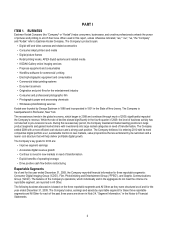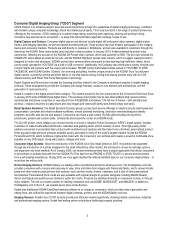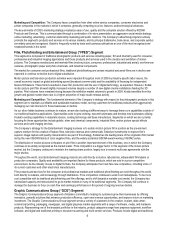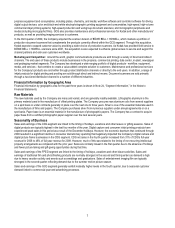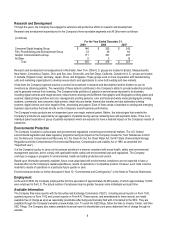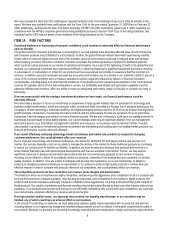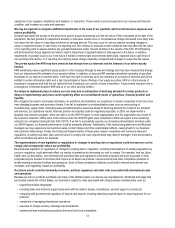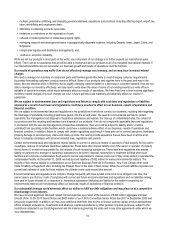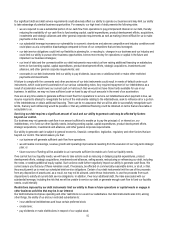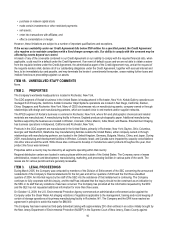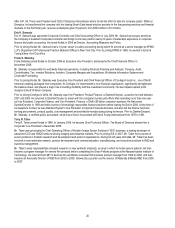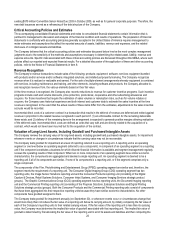Kodak 2009 Annual Report Download - page 16
Download and view the complete annual report
Please find page 16 of the 2009 Kodak annual report below. You can navigate through the pages in the report by either clicking on the pages listed below, or by using the keyword search tool below to find specific information within the annual report. 14
• multiple, potentially conflicting, and changing governmental laws, regulations and practices, including differing export, import, tax,
labor, anti-bribery and employment laws;
• difficulties in collecting accounts receivable;
• limitations or restrictions on the repatriation of cash;
• reduced or limited protection of intellectual property rights;
• managing research and development teams in geographically disparate locations, including Canada, Israel, Japan, China, and
Singapore;
• complicated logistics and distribution arrangements; and
• political or economic instability.
While we sell our products in most parts of the world, one component of our strategy is to further expand our international sales
efforts. There can be no assurance that we will be able to market and sell our products in all of our targeted international markets. If
our international efforts are not successful, our business growth and results of operations could be harmed.
Our results of operations may suffer if we do not effectively manage our inventory, and we may incur inventory-related
charges.
We need to manage our inventory of component parts and finished goods effectively to meet changing customer requirements.
Accurately forecasting customers’ product needs is difficult. Some of our products and supplies have in the past, and may in the
future, become obsolete while in inventory due to rapidly changing customer tastes or a decrease in customer demand. If we are not
able to manage our inventory effectively, we may need to write down the value of some of our existing inventory or write off non-
saleable or obsolete inventory, which would adversely affect our results of operations. We have from time to time incurred significant
inventory-related charges. Any such charges we incur in future periods could materially and adversely affect our results of
operations.
We are subject to environmental laws and regulations and failure to comply with such laws and regulations or liabilities
imposed as a result of such laws and regulations could have an adverse effect on our business, results of operations and
financial condition.
We are subject to environmental laws and regulations in the jurisdictions in which we conduct our business, including laws regarding
the discharge of pollutants, including greenhouse gases, into the air and water, the need for environmental permits for certain
operations, the management and disposal of hazardous substances and wastes, the cleanup of contaminated sites, the content of
our products and the recycling and treatment and disposal of our products. If we do not comply with applicable laws and regulations
in connection with the use and management of hazardous substances, then we could be subject to liability and/or could be
prohibited from operating certain facilities, which could have a material adverse effect on our business, results of operations and
financial condition. In addition, failure to comply with certain regulations could result in fines and civil or criminal sanctions, third-party
property damage or personal injury claims and clean up costs. We cannot provide assurance that we have been or will be at all
times in complete compliance with all environmental laws, regulations and permits.
Certain environmental laws and regulations impose liability on current or previous owners or operators of real property for the cost to
investigate, remove or remediate hazardous substances. These laws often impose liability even if the owner or operator of property
did not know of, or was not responsible for, the release of such hazardous substances. These laws and regulations also assess
liability on persons who arrange for hazardous substances to be sent to disposal, reclamation or treatment facilities when such
facilities are found to be contaminated. Such persons can be responsible for cleanup costs even if they never owned or operated the
contaminated facility. At December 31, 2009, we had accrued liabilities of $102 million for various environmental matters. The
majority of this reserve relates to contamination at our Eastman Business Park site in Rochester, New York. Certain other costs
relate to liability at Superfund sites, including the Passaic River in the state of New Jersey. While the accrued liabilities represent our
current best estimate of costs for those matters, the ultimate costs could exceed that amount.
Environmental laws and regulations are complex, change frequently and have tended to become more stringent over time. We
cannot assure you that our costs of complying with current and future environmental laws and regulations and our liabilities arising
from past or future releases of, or exposure to, hazardous substances (including our liability for the matters comprising our
environmental reserve) will not adversely affect our business, results of operations or financial condition.
Our substantial leverage could adversely affect our ability to fulfill our debt obligations and may place us at a competitive
disadvantage in our industry.
We have incurred significant debt and related interest expenses as a result of the issuance of $300 million aggregate principal
amount of the 10.5% 2017 Senior Notes and $400 million of our 7.00% Convertible Senior Notes due 2017 in September 2009 and
previously issued debt. In addition, we may incur additional debt from time to time to finance working capital, product development
efforts, strategic acquisitions, investments and alliances, capital expenditures or other general corporate purposes, subject to the
restrictions contained in our Credit Agreement and the indenture governing the notes and in any other agreements under which we
incur indebtedness.


